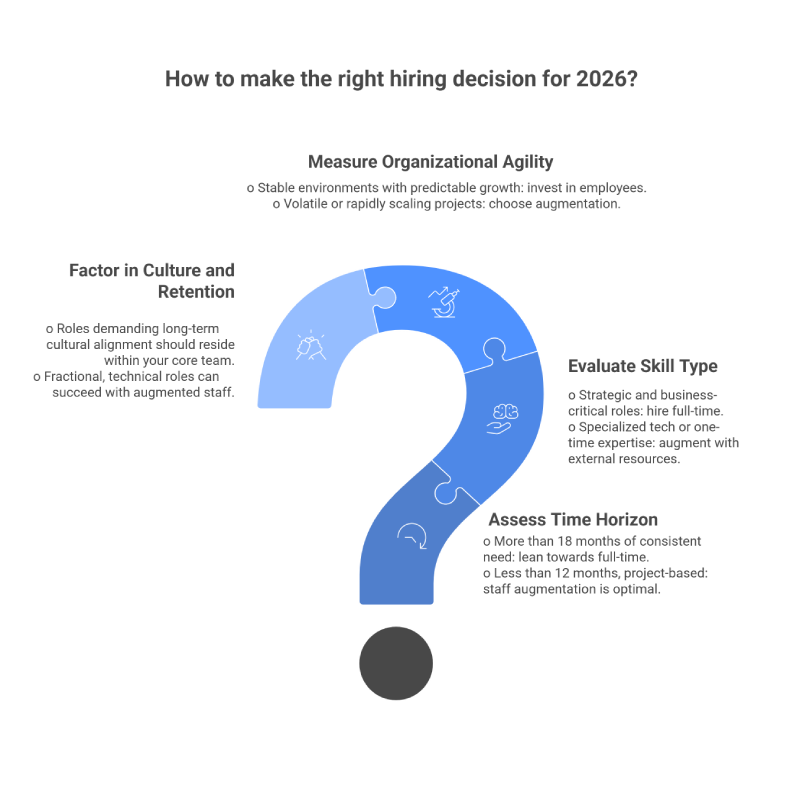As businesses move toward 2026, workforce strategies are once again at the center of C-suite discussions. Economic uncertainty, technology acceleration, and evolving employee expectations are reshaping how organizations build their teams. For CEOs, CIOs, and HR Directors, the critical question is no longer simply “who do we hire?”—it’s “how should we hire?”
Finding the right balance between full-time employees and staff augmentation can be the difference between agility and stagnation, between cost efficiency and talent shortages. Here’s how to think strategically about staffing for 2026.
The Workforce Landscape in 2026
Three trends are driving new considerations in workforce planning
- • Skill Gaps Are Widening : With AI, cybersecurity, and digital transformation initiatives progressing rapidly, many organizations face pressure to acquire niche skills not easily filled internally..
- • Workplace Expectations Have Shifted : Employees increasingly demand flexibility, purpose, and continuous development, making retention and engagement as critical as recruitment.
- • Economic Cycles Are Less Predictable : Businesses must remain resilient, scaling teams up or down without the financial burden of long-term fixed costs. Against this backdrop, leaders must decide when full-time hiring is the right approach, and when staff augmentation offers a smarter alternative.
When Full-Time Hiring Makes Sense
Hiring permanent employees remains essential at the core of a stable workforce. Consider full-time recruitment when:
- • You Need Institutional Knowledge : Long-term strategic roles—such as enterprise architects, product managers, or IT leaders—require deep immersion in company culture, processes, and strategy. These are roles where tenure and alignment are invaluable.
- • The Workload is Stable and Predictable : If you have ongoing, consistent needs—like maintaining IT infrastructure, managing HR systems, or running sales campaigns—full-time employees provide continuity and reliability.
- • Leadership and Ownership Are Required : Projects with significant cross-functional impact require leaders who can take long-term responsibility. Augmented staff can support, but company vision is best driven by people fully invested in your success.
- • Retention Builds Long-Term Value : For business-critical areas, every year an employee stays adds compounding organizational value. Knowledge transfer, mentoring, and cultural alignment cannot easily be outsourced.
When IT Staff Augmentation Is the Better Choice
Staff augmentation provides flexibility by giving organizations access to on-demand professionals from specialized IT skills to development teams. It’s the right fit when:
- • You Face Short-Term Resource Gaps : If a project requires immediate scaling—say, rolling out a new cloud system or building a mobile app—bringing in short-term specialists is more efficient and faster than a lengthy recruitment cycle.
- • You Need Niche or Emerging Skills : Finding experienced blockchain developers, AI/ML engineers, or cybersecurity specialists as full-time hires can be time-consuming and expensive. Augmentation lets you tap into this talent without long-term commitment.
- • You’re Managing Cost Efficiency : Augmentation reduces investment in benefits, training, and long-term overhead. This allows businesses to align costs with opportunities, scaling teams exactly as projects demand.
- • You Want to Reduce Risk : Engaging external professionals enables you to test their fit for your business, sometimes leading to “contract-to-hire” opportunities, while minimizing the risk of a poor permanent hire.
The Decision Framework for 2026
So, how can HR Directors and CXOs make the right call ?
Bringing It All Together
The smartest organizations entering 2026 aren’t asking whether to invest in full-time hiring or staff augmentation —they’re embracing both. A blended workforce model offers the stability of a loyal, committed team alongside the agility and specialized expertise of augmented professionals.
At Oasys Tech Solutions, we’ve seen this hybrid approach empower our clients to innovate faster, control costs, and remain versatile in uncertain times. By helping leaders identify gaps and strategically deploy talent, we ensure organizations are equipped for whatever 2026 brings.
Final Thought
In today’s business environment, talent isn’t just a resource—it’s a competitive advantage. Your ability to build the right team at the right time will shape how effectively you innovate, adapt, and lead in the coming year.
As you plan your workforce strategy for 2026, take a step back: Which roles truly require permanent in-house expertise, and where could staff augmentation drive sharper, faster results? The answer to that question could well define your organization’s success in the year ahead.
Authored by
Subrat Swain, Comms, Brand and Socials
subrat.swain@oasystspl.com


